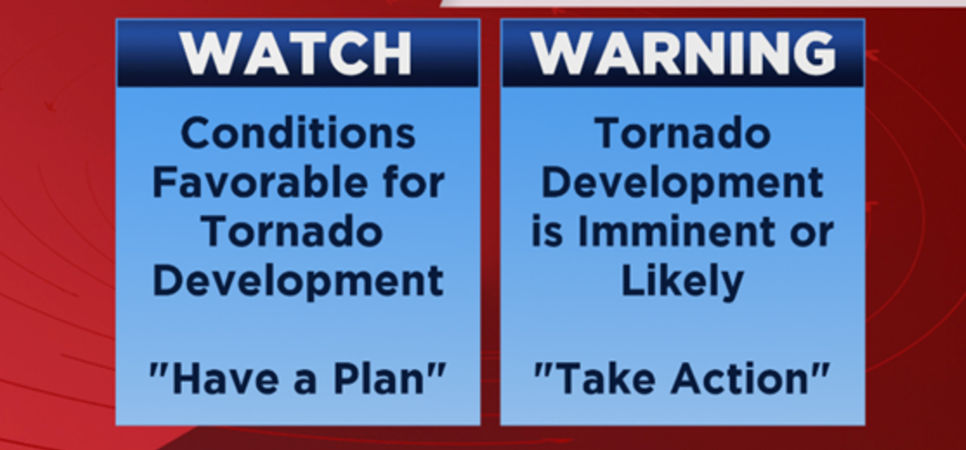Understanding the Differences Between a Tornado Warning and a Tornado Watch
What Is a Tornado Watch?
- Meteorologists issue a tornado watch when conditions favour tornado development in a specific location. Rather than signalling the imminent arrival of a tornado, this alert calls for increased awareness as a precaution. Although meteorologists haven’t observed any tornadoes, the watch suggests that conditions are ripe for their formation. It is crucial for people to stay alert and prepare during such times.
How Meteorologists Issue a Tornado Watch
- Meteorologists carefully analyse various meteorological patterns before issuing a tornado watch. Using advanced radar technology, experts assess severe storms, wind patterns, and other atmospheric factors that may contribute to tornado formation. Meteorologists issue the watch when they detect conditions that could lead to a tornado’s development. These evaluations depend on storm path prediction models and real-time observations.
Why It Is Important to Understand a Tornado Watch
- Understanding what a tornado watch means is crucial to ensuring safety. Although it does not guarantee that a tornado will happen, it signals the need for heightened awareness. People should monitor weather developments closely and stay ready to act if necessary. If a tornado warning is later issued, being informed and prepared could significantly improve a community’s response. Tornado conditions can change quickly, so staying prepared is essential.
What Is a Tornado Warning?
- The National Weather Service (NWS) issues a tornado warning when a tornado has been spotted or detected by radar. Unlike a tornado watch, which suggests that tornado conditions are possible, a warning confirms that a tornado is imminent or already occurring. This notice requires immediate action to protect life and property in the affected area. It is a critical alert that signals urgent danger.

Key Differences Between a Tornado Warning and a Tornado Watch
- Understanding the distinctions between a tornado warning and a tornado watch is essential for personal safety during severe weather. A tornado watch is issued when conditions favour tornado formation, although none have been observed yet. It signals a potential threat, urging residents to stay alert and prepare. In contrast, a tornado warning is issued when meteorologists detect a tornado, signalling that immediate action is necessary to protect life and property. People should seek shelter in a safe place immediately.
Using Visual Aids to Understand the Differences
- Visual aids, such as comparison charts, help to clarify the differences between a tornado watch and a tornado warning. These charts often include definitions for each term and practical advice on how to respond. For example, a warning requires swift protective actions, while a watch encourages vigilance and preparation. These visual tools can enhance understanding and preparedness in tornado-prone areas.
Why It Is Important to Know the Difference Between a Tornado Watch and a Tornado Warning
- Knowing the difference between a tornado watch and a tornado warning could be life-saving. It ensures that people respond correctly to severe weather, prioritising safety for themselves and their loved ones. In tornado-prone regions, awareness of these alerts is crucial for effective disaster preparedness. This enables communities to act promptly when needed.
Safety Tips During Tornado Warnings
Preparing for a Tornado Watch
- Tornadoes can strike suddenly, so it is vital for people and families in high-risk areas to stay informed and prepared. A tornado watch means that conditions are favourable for tornado development, making it important to stay vigilant. Always ensure that your emergency bag is ready, including essentials such as water, non-perishable food, a torch, a first aid kit, and any necessary prescription medications. Regularly check and update your emergency kit to ensure its effectiveness.
Immediate Actions During a Tornado Warning
- Once a tornado warning is issued, immediate action is necessary, as a tornado has either been observed or detected by radar. Identify a safe location within your home, ideally a room on the lowest level, away from windows, such as a basement. If a basement is unavailable, choose an interior room like a bathroom or closet. Work with your family to create a plan for quickly reaching the safe location and designate a meeting point in case you get separated during an emergency.
Staying Informed During a Tornado Watch or Warning
- Staying informed is crucial when a tornado watch or warning is issued. Ensure that you have access to reliable local weather services. Sign up for weather alerts that provide up-to-date information on tornado watches and warnings. Use NOAA weather radios or weather apps on your phone to receive timely updates. Keep an eye on local forecasts, especially during tornado season, and watch for any weather changes that might signal a tornado threat.
Practising Your Tornado Protection Plan
- Regularly practising your tornado protection plan with your family can significantly improve safety during an emergency. This helps everyone become familiar with the plan and ensures a quicker, more effective response when a tornado threat arises. The more prepared and organised you are, the more likely you are to reduce the risks associated with tornadoes and protect yourself and your family during a storm.


